สคีมา DSPL
จัดทุกอย่างให้เป็นระเบียบอยู่เสมอด้วยคอลเล็กชัน
บันทึกและจัดหมวดหมู่เนื้อหาตามค่ากำหนดของคุณ
หน้านี้และหน้าย่อยที่ลิงก์จะแสดงสคีมา DSPL XML
เนื้อหานี้มีไว้สำหรับผู้ใช้ขั้นสูงที่ต้องการทำความเข้าใจ
รายละเอียดระดับต่ำของภาษา สำหรับผู้ใช้ส่วนใหญ่ เนื้อหา
ใน
คู่มือนักพัฒนาซอฟต์แวร์ควรเพียงพอสำหรับการสร้างและแก้ไข
ชุดข้อมูล DSPL
สคีมา XML ที่สมบูรณ์มีให้ดาวน์โหลดในรูปแบบ XSD
ใน
เว็บไซต์รหัส DSPL
องค์ประกอบ: dspl
| เนมสเปซ |
http://schemas.google.com/dspl/2010 |
| คำอธิบายประกอบ |
ข้อกำหนด DSPL อธิบายถึงชุดข้อมูล ชุดข้อมูลคือ
ที่ระบุโดยเนมสเปซ ชุดข้อมูลประกอบด้วยข้อมูลต่อไปนี้
องค์ประกอบ: - ตาราง: ข้อมูลสำหรับแนวคิดและส่วนที่กำหนดไว้ในองค์ประกอบ
ชุดข้อมูล - แนวคิด: คำจำกัดความและโครงสร้างที่ผู้ใช้ระบุซึ่งใช้ใน
ชุดข้อมูล - ส่วนแบ่ง: ชุดค่าผสมของมิติข้อมูลและเมตริกที่มีอยู่ใน
ชุดข้อมูล - หัวข้อ: ป้ายกำกับแบบลำดับชั้นที่ใช้เพื่อจัดระเบียบแนวคิดของ
ชุดข้อมูล |
| แผนภาพ |
 |
| พร็อพเพอร์ตี้ |
|
| รุ่น |
นำเข้า* , ข้อมูล , ผู้ให้บริการ ,
แอตทริบิวต์* , หัวข้อ{0,1} , แนวคิด{0,1} , ส่วนแบ่ง{0,1} ตาราง{0,1} |
| เด็ก |
แอตทริบิวต์, แนวคิด, นำเข้า
ข้อมูล, ผู้ให้บริการ, ส่วน
ตาราง หัวข้อ |
| อินสแตนซ์ |
<dspl targetNamespace="">
<import location="" namespace="">{0,unbounded}</import>
<info>{1,1}</info>
<provider>{1,1}</provider>
<attribute concept="" id="">{0,unbounded}</attribute>
<topics>{0,1}</topics>
<concepts>{0,1}</concepts>
<slices>{0,1}</slices>
<tables>{0,1}</tables>
</dspl>
|
| Attributes |
| QName |
ประเภท |
คงที่ |
ค่าเริ่มต้น |
ใช้ |
หมายเหตุ |
| targetNamespace |
xs:anyURI |
|
|
ไม่บังคับ |
ชุดข้อมูลแต่ละชุดอาจมีเนมสเปซเป้าหมาย เป้าหมาย
Namespace คือ URI ที่ระบุชุดข้อมูลโดยไม่ซ้ำกัน สำหรับข้อมูลเพิ่มเติม
ข้อมูลเกี่ยวกับการใช้เนมสเปซใน XML โปรดดู
http://www.w3.org/TR/REC-xml-names/ หากไม่มี targetNamespace คือ
ที่ระบุ ระบบจะสร้างเนมสเปซเมื่อชุดข้อมูลคือ
นำเข้ามาเท่านั้น |
|
| แหล่งที่มา |
<xs:element name="dspl">
<xs:annotation>
<xs:documentation>A DSPL specification describes a dataset. A dataset is
identified by its namespace. A dataset is comprised of the
following elements:
- Tables: Data for the concepts and slices defined in the
dataset
- Concepts: User-specified definitions and structures used in
the dataset
- Slices: Combinations of dimensions and metrics present in
the dataset
- Topics: Hierarchical labels used to organise the concepts of
the dataset</xs:documentation>
</xs:annotation>
<xs:complexType>
<xs:sequence>
<xs:element name="import" minOccurs="0" maxOccurs="unbounded">
<xs:annotation>
<xs:documentation>Import directive for external datasets -- modeled after
the XML Schema import directive. In order to use
elements defined in an external dataset, the external
dataset must be referenced using an import directive.</xs:documentation>
</xs:annotation>
<xs:complexType>
<xs:attribute name="namespace" use="required">
<xs:annotation>
<xs:documentation>The namespace of the imported dataset, specified as
a URI. A prefix must be associated with this
namespace before its contents can be referenced. See
[XML Namespaces] for more information about the use
of namespaces and prefixes in XML.</xs:documentation>
</xs:annotation>
</xs:attribute>
<xs:attribute name="location" use="optional">
<xs:annotation>
<xs:documentation>An optional location where the definition of the
imported dataset can be found, specified as a
URL. If the location is omitted, the system
processing this DSPL dataset must already know the
imported dataset.
Implementation note: The Google dataset importer
ignores the location attribute. Any imported dataset
must be known by the Google importer beforehand.</xs:documentation>
</xs:annotation>
</xs:attribute>
</xs:complexType>
</xs:element>
<xs:element name="info" type="Info" minOccurs="1">
<xs:annotation>
<xs:documentation>General information about the dataset.</xs:documentation>
</xs:annotation>
</xs:element>
<xs:element name="provider" type="Info">
<xs:annotation>
<xs:documentation>General information about the dataset provider.</xs:documentation>
</xs:annotation>
</xs:element>
<xs:element name="attribute" type="Attribute" minOccurs="0" maxOccurs="unbounded">
<xs:annotation>
<xs:documentation>Attribute associated with the dataset.</xs:documentation>
</xs:annotation>
</xs:element>
<xs:element name="topics" minOccurs="0">
<xs:annotation>
<xs:documentation>A hierarchy of topics used to organize the contents of
the dataset. The order in which topics are given is
meaningful and should be respected by visualizations
that displays these topics.</xs:documentation>
</xs:annotation>
<xs:complexType>
<xs:sequence>
<xs:element name="topic" type="Topic" maxOccurs="unbounded"/>
</xs:sequence>
</xs:complexType>
</xs:element>
<xs:element name="concepts" minOccurs="0">
<xs:annotation>
<xs:documentation>A list of concepts defined in this dataset.</xs:documentation>
</xs:annotation>
<xs:complexType>
<xs:sequence>
<xs:element name="concept" type="Concept" maxOccurs="unbounded"/>
</xs:sequence>
</xs:complexType>
</xs:element>
<xs:element name="slices" minOccurs="0">
<xs:annotation>
<xs:documentation>A list of slices defined in this dataset.</xs:documentation>
</xs:annotation>
<xs:complexType>
<xs:sequence>
<xs:element name="slice" type="Slice" maxOccurs="unbounded"/>
</xs:sequence>
</xs:complexType>
</xs:element>
<xs:element name="tables" minOccurs="0">
<xs:annotation>
<xs:documentation>A list of tables defined in this dataset.</xs:documentation>
</xs:annotation>
<xs:complexType>
<xs:sequence>
<xs:element name="table" type="Table" maxOccurs="unbounded"/>
</xs:sequence>
</xs:complexType>
</xs:element>
</xs:sequence>
<xs:attribute name="targetNamespace" type="xs:anyURI" use="optional">
<xs:annotation>
<xs:documentation>Each dataset may provide a target namespace. The
target namespace is a URI that uniquely identifies the
dataset. For more information about the use of namespaces in XML,
see:
http://www.w3.org/TR/REC-xml-names/
If no targetNamespace is provided, then a namespace will be
generated when the dataset is imported.</xs:documentation>
</xs:annotation>
</xs:attribute>
</xs:complexType>
</xs:element>
|
องค์ประกอบ: dspl / นำเข้า
| เนมสเปซ |
http://schemas.google.com/dspl/2010 |
| คำอธิบายประกอบ |
คำสั่งการนำเข้าสำหรับชุดข้อมูลภายนอก ซึ่งจำลองตาม XML
คำสั่งการนำเข้าสคีมา เพื่อใช้องค์ประกอบที่กำหนดไว้ในองค์ประกอบภายนอก
ชุดข้อมูลภายนอกต้องอ้างอิงโดยใช้การนำเข้า
|
| แผนภาพ |
 |
| พร็อพเพอร์ตี้ |
| เนื้อหา: |
ซับซ้อน |
| ขั้นต่ำ: |
0 |
| maxOccurs: |
ไร้ขอบเขต |
|
| Attributes |
| QName |
ประเภท |
คงที่ |
ค่าเริ่มต้น |
ใช้ |
หมายเหตุ |
| ตำแหน่ง |
|
|
|
ไม่บังคับ |
ตำแหน่งที่ไม่บังคับซึ่งคำจำกัดความของที่นำเข้า
ระบุเป็น URL ได้ หากสถานที่คือ
ละเว้น ระบบที่ประมวลผลชุดข้อมูล DSPL ต้องทราบอยู่แล้ว
ชุดข้อมูลที่นำเข้า หมายเหตุการใช้งาน: ชุดข้อมูล Google
ผู้นำเข้าไม่สนใจแอตทริบิวต์ตำแหน่ง ชุดข้อมูลที่นำเข้าต้อง
ของผู้นำเข้าของ Google รู้จักล่วงหน้า |
| เนมสเปซ |
|
|
|
จำเป็น |
เนมสเปซของชุดข้อมูลที่นำเข้า ซึ่งระบุเป็น
URI คำนำหน้าต้องเชื่อมโยงกับเนมสเปซนี้ก่อนที่จะ
สามารถอ้างอิงเนื้อหาได้ ดู [เนมสเปซ XML] เพิ่มเติม
ข้อมูลเกี่ยวกับการใช้เนมสเปซและคำนำหน้าใน
XML |
|
| แหล่งที่มา |
<xs:element name="import" minOccurs="0" maxOccurs="unbounded">
<xs:annotation>
<xs:documentation>Import directive for external datasets -- modeled after
the XML Schema import directive. In order to use
elements defined in an external dataset, the external
dataset must be referenced using an import directive.</xs:documentation>
</xs:annotation>
<xs:complexType>
<xs:attribute name="namespace" use="required">
<xs:annotation>
<xs:documentation>The namespace of the imported dataset, specified as
a URI. A prefix must be associated with this
namespace before its contents can be referenced. See
[XML Namespaces] for more information about the use
of namespaces and prefixes in XML.</xs:documentation>
</xs:annotation>
</xs:attribute>
<xs:attribute name="location" use="optional">
<xs:annotation>
<xs:documentation>An optional location where the definition of the
imported dataset can be found, specified as a
URL. If the location is omitted, the system
processing this DSPL dataset must already know the
imported dataset.
Implementation note: The Google dataset importer
ignores the location attribute. Any imported dataset
must be known by the Google importer beforehand.</xs:documentation>
</xs:annotation>
</xs:attribute>
</xs:complexType>
</xs:element>
|
องค์ประกอบ: dspl / ข้อมูล
| เนมสเปซ |
http://schemas.google.com/dspl/2010 |
| คำอธิบายประกอบ |
ข้อมูลทั่วไปเกี่ยวกับชุดข้อมูล |
| แผนภาพ |
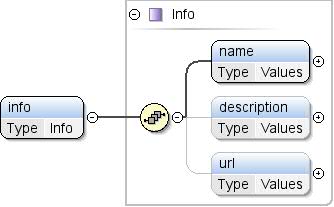 |
| ประเภท |
ข้อมูล |
| พร็อพเพอร์ตี้ |
| เนื้อหา: |
ซับซ้อน |
| ขั้นต่ำ: |
1 |
|
| รุ่น |
ชื่อ , คำอธิบาย{0,1} , url{0,1} |
| เด็ก |
รายละเอียด ชื่อ url |
| อินสแตนซ์ |
<info>
<name>{1,1}</name>
<description>{0,1}</description>
<url>{0,1}</url>
</info>
|
| แหล่งที่มา |
<xs:element name="info" type="Info" minOccurs="1">
<xs:annotation>
<xs:documentation>General information about the dataset.</xs:documentation>
</xs:annotation>
</xs:element>
|
องค์ประกอบ: dspl / provider
| เนมสเปซ |
http://schemas.google.com/dspl/2010 |
| คำอธิบายประกอบ |
ข้อมูลทั่วไปเกี่ยวกับผู้ให้บริการชุดข้อมูล |
| แผนภาพ |
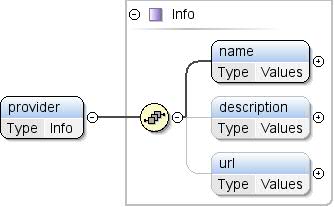 |
| ประเภท |
ข้อมูล |
| พร็อพเพอร์ตี้ |
|
| รุ่น |
ชื่อ , คำอธิบาย{0,1} , url{0,1} |
| เด็ก |
รายละเอียด ชื่อ url |
| อินสแตนซ์ |
<provider>
<name>{1,1}</name>
<description>{0,1}</description>
<url>{0,1}</url>
</provider>
|
| แหล่งที่มา |
<xs:element name="provider" type="Info">
<xs:annotation>
<xs:documentation>General information about the dataset provider.</xs:documentation>
</xs:annotation>
</xs:element>
|
องค์ประกอบ: dspl / แอตทริบิวต์
| เนมสเปซ |
http://schemas.google.com/dspl/2010 |
| คำอธิบายประกอบ |
แอตทริบิวต์ที่เชื่อมโยงกับชุดข้อมูล |
| แผนภาพ |
 |
| ประเภท |
แอตทริบิวต์ |
| พร็อพเพอร์ตี้ |
| เนื้อหา: |
ซับซ้อน |
| ขั้นต่ำ: |
0 |
| maxOccurs: |
ไร้ขอบเขต |
|
| รุ่น |
info{0,1} , type{0,1} , (ค่า*
| conceptValue{0,1}) |
| เด็ก |
conceptValue, info, type
ค่า |
| อินสแตนซ์ |
<attribute concept="" id="">
<info>{0,1}</info>
<type format="" ref="">{0,1}</type>
</attribute>
|
| Attributes |
| QName |
ประเภท |
คงที่ |
ค่าเริ่มต้น |
ใช้ |
หมายเหตุ |
| แนวคิด |
xs:QName |
|
|
ไม่บังคับ |
การอ้างอิงแนวคิดที่สอดคล้องกับค่าต่างๆ
ของแอตทริบิวต์ หากแอตทริบิวต์ระบุประเภท แล้วประเภท
ต้องตรงกับประเภทของแนวคิดที่อ้างอิง การอ้างอิงถึง
แนวคิดภายนอกต้องอยู่ในรูปแบบ
"prefix:other_concept_id" โดยที่ "คำนำหน้า" เท่ากับ
คำนำหน้าที่ใช้สำหรับเนมสเปซของชุดข้อมูลภายนอก (ดู XML
เนมสเปซ) |
| id |
LocalId |
|
|
ไม่บังคับ |
รหัสของแอตทริบิวต์แนวคิด ตัวระบุนี้ต้องเป็น
ไม่ซ้ำกันภายในแนวคิด (ทั้งแอตทริบิวต์และพร็อพเพอร์ตี้)
อาจละเว้น id ได้หากมีการระบุแอตทริบิวต์แนวคิดไว้ ในนั้น
รหัสคือความเรียบง่ายที่สร้างขึ้นด้วยค่า ชื่อท้องถิ่นของ
แนวคิดที่อ้างอิง เช่น <attribute
concept="unit:currency"/> เทียบเท่ากับ
<attribute id="currency"
concept="unit:currency"/> |
|
| แหล่งที่มา |
<xs:element name="attribute" type="Attribute" minOccurs="0" maxOccurs="unbounded">
<xs:annotation>
<xs:documentation>Attribute associated with the dataset.</xs:documentation>
</xs:annotation>
</xs:element>
|
องค์ประกอบ: dspl / หัวข้อ
| เนมสเปซ |
http://schemas.google.com/dspl/2010 |
| คำอธิบายประกอบ |
ลำดับชั้นของหัวข้อที่ใช้ในการจัดระเบียบเนื้อหาของ
ชุดข้อมูล ลำดับของหัวข้อนั้นมีความหมายและควร
โดยใช้ภาพที่แสดงหัวข้อเหล่านี้ |
| แผนภาพ |
 |
| พร็อพเพอร์ตี้ |
| เนื้อหา: |
ซับซ้อน |
| ขั้นต่ำ: |
0 |
|
| รุ่น |
หัวข้อ+ |
| เด็ก |
หัวข้อ |
| อินสแตนซ์ |
<topics>
<topic id="" parentTopic="">{1,unbounded}</topic>
</topics>
|
| แหล่งที่มา |
<xs:element name="topics" minOccurs="0">
<xs:annotation>
<xs:documentation>A hierarchy of topics used to organize the contents of
the dataset. The order in which topics are given is
meaningful and should be respected by visualizations
that displays these topics.</xs:documentation>
</xs:annotation>
<xs:complexType>
<xs:sequence>
<xs:element name="topic" type="Topic" maxOccurs="unbounded"/>
</xs:sequence>
</xs:complexType>
</xs:element>
|
องค์ประกอบ: dspl / topics / topic
| เนมสเปซ |
http://schemas.google.com/dspl/2010 |
| แผนภาพ |
 |
| ประเภท |
หัวข้อ |
| พร็อพเพอร์ตี้ |
| เนื้อหา: |
ซับซ้อน |
| maxOccurs: |
ไร้ขอบเขต |
|
| รุ่น |
ข้อมูล , หัวข้อ* |
| เด็ก |
ข้อมูล, หัวข้อ |
| อินสแตนซ์ |
<topic id="" parentTopic="">
<info>{1,1}</info>
<topic id="" parentTopic="">{0,unbounded}</topic>
</topic>
|
| Attributes |
| QName |
ประเภท |
คงที่ |
ค่าเริ่มต้น |
ใช้ |
หมายเหตุ |
| id |
รหัส |
|
|
จำเป็น |
ตัวระบุที่ไม่ซ้ำกันของหัวข้อใน
ชุดข้อมูล |
| parentTopic |
xs:QName |
|
|
ไม่บังคับ |
รหัสของหัวข้อหลักของหัวข้อนี้ หากมี
ระบุ parentTopic สำหรับหัวข้อที่แทรกอยู่ภายในไม่ได้
หัวข้ออื่นๆ |
|
| แหล่งที่มา |
<xs:element name="topic" type="Topic" maxOccurs="unbounded"/>
|
องค์ประกอบ: dspl / แนวคิด
| เนมสเปซ |
http://schemas.google.com/dspl/2010 |
| คำอธิบายประกอบ |
รายการแนวคิดที่กำหนดไว้ในชุดข้อมูลนี้ |
| แผนภาพ |
 |
| พร็อพเพอร์ตี้ |
| เนื้อหา: |
ซับซ้อน |
| ขั้นต่ำ: |
0 |
|
| รุ่น |
แนวคิด+ |
| เด็ก |
แนวคิด |
| อินสแตนซ์ |
<concepts>
<concept extends="" id="">{1,unbounded}</concept>
</concepts>
|
| แหล่งที่มา |
<xs:element name="concepts" minOccurs="0">
<xs:annotation>
<xs:documentation>A list of concepts defined in this dataset.</xs:documentation>
</xs:annotation>
<xs:complexType>
<xs:sequence>
<xs:element name="concept" type="Concept" maxOccurs="unbounded"/>
</xs:sequence>
</xs:complexType>
</xs:element>
|
องค์ประกอบ: dspl / แนวคิด / แนวคิด
| เนมสเปซ |
http://schemas.google.com/dspl/2010 |
| แผนภาพ |
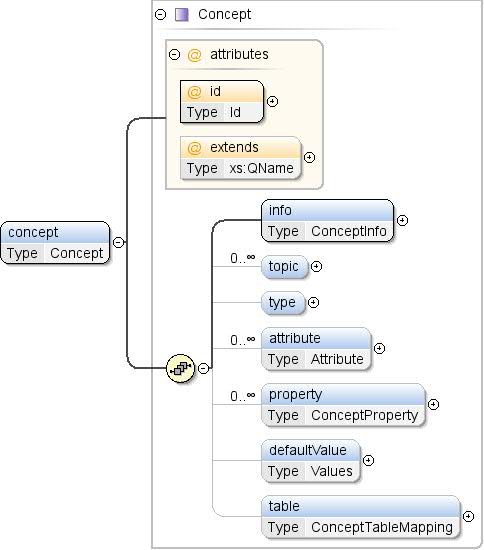 |
| ประเภท |
แนวคิด |
| พร็อพเพอร์ตี้ |
| เนื้อหา: |
ซับซ้อน |
| maxOccurs: |
ไร้ขอบเขต |
|
| รุ่น |
info , topic* , type{0,1} ,
แอตทริบิวต์* , พร็อพเพอร์ตี้* , defaultValue{0,1} ตาราง{0,1} |
| เด็ก |
attribute, defaultValue, ข้อมูล
พร็อพเพอร์ตี้ ตาราง หัวข้อ
ประเภท |
| อินสแตนซ์ |
<concept extends="" id="">
<info>{1,1}</info>
<topic ref="">{0,unbounded}</topic>
<type ref="">{0,1}</type>
<attribute concept="" id="">{0,unbounded}</attribute>
<property concept="" id="" isMapping="false" isParent="false">{0,unbounded}</property>
<defaultValue>{0,1}</defaultValue>
<table ref="">{0,1}</table>
</concept>
|
| Attributes |
| QName |
ประเภท |
คงที่ |
ค่าเริ่มต้น |
ใช้ |
หมายเหตุ |
| ขยาย |
xs:QName |
|
|
ไม่บังคับ |
ตัวระบุที่ไม่ซ้ำของแนวคิดที่แนวคิดนี้
ขยาย ระบบอาจกำหนดแนวคิดที่อ้างอิงในชุดข้อมูลเดียวกัน
หรือภายนอก ซึ่งก็คือชุดข้อมูลอื่น การอ้างอิงไปยังภายนอก
แนวคิดต้องอยู่ในรูปแบบ "prefix:other_concept_id"
โดยที่ "คำนำหน้า" เป็นคำนำหน้าที่ใช้สำหรับเนมสเปซของ
ชุดข้อมูลภายนอก (ดูเนมสเปซ XML) |
| id |
รหัส |
|
|
จำเป็น |
ตัวระบุที่ไม่ซ้ำกันของแนวคิด ซึ่งต้อง
ที่ไม่ซ้ำกันทั่วโลกภายในชุดข้อมูลนี้ |
|
| แหล่งที่มา |
<xs:element name="concept" type="Concept" maxOccurs="unbounded"/>
|
องค์ประกอบ: dspl / ส่วน
| เนมสเปซ |
http://schemas.google.com/dspl/2010 |
| คำอธิบายประกอบ |
รายการส่วนที่กำหนดไว้ในชุดข้อมูลนี้ |
| แผนภาพ |
 |
| พร็อพเพอร์ตี้ |
| เนื้อหา: |
ซับซ้อน |
| ขั้นต่ำ: |
0 |
|
| รุ่น |
Slice+ |
| เด็ก |
สไลซ์ |
| อินสแตนซ์ |
<slices>
<slice id="">{1,unbounded}</slice>
</slices>
|
| แหล่งที่มา |
<xs:element name="slices" minOccurs="0">
<xs:annotation>
<xs:documentation>A list of slices defined in this dataset.</xs:documentation>
</xs:annotation>
<xs:complexType>
<xs:sequence>
<xs:element name="slice" type="Slice" maxOccurs="unbounded"/>
</xs:sequence>
</xs:complexType>
</xs:element>
|
องค์ประกอบ: dspl / slices / Slice
| เนมสเปซ |
http://schemas.google.com/dspl/2010 |
| แผนภาพ |
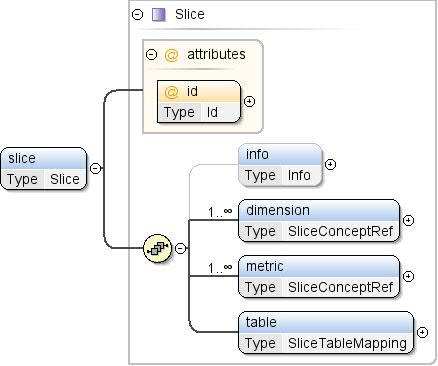 |
| ประเภท |
สไลซ์ |
| พร็อพเพอร์ตี้ |
| เนื้อหา: |
ซับซ้อน |
| maxOccurs: |
ไร้ขอบเขต |
|
| รุ่น |
info{0,1} , dimension+ , metric+
, ตาราง |
| เด็ก |
มิติข้อมูล ข้อมูล เมตริก
ตาราง |
| อินสแตนซ์ |
<slice id="">
<info>{0,1}</info>
<dimension concept="">{1,unbounded}</dimension>
<metric concept="">{1,unbounded}</metric>
<table ref="">{1,1}</table>
</slice>
|
| Attributes |
| QName |
ประเภท |
คงที่ |
ค่าเริ่มต้น |
ใช้ |
หมายเหตุ |
| id |
รหัส |
|
|
จำเป็น |
ตัวระบุที่ไม่ซ้ำกันของสไลซ์ |
|
| แหล่งที่มา |
<xs:element name="slice" type="Slice" maxOccurs="unbounded"/>
|
องค์ประกอบ: dspl / ตาราง
| เนมสเปซ |
http://schemas.google.com/dspl/2010 |
| คำอธิบายประกอบ |
รายการตารางที่กำหนดไว้ในชุดข้อมูลนี้ |
| แผนภาพ |
 |
| พร็อพเพอร์ตี้ |
| เนื้อหา: |
ซับซ้อน |
| ขั้นต่ำ: |
0 |
|
| รุ่น |
table+ |
| เด็ก |
ตาราง |
| อินสแตนซ์ |
<tables>
<table id="">{1,unbounded}</table>
</tables>
|
| แหล่งที่มา |
<xs:element name="tables" minOccurs="0">
<xs:annotation>
<xs:documentation>A list of tables defined in this dataset.</xs:documentation>
</xs:annotation>
<xs:complexType>
<xs:sequence>
<xs:element name="table" type="Table" maxOccurs="unbounded"/>
</xs:sequence>
</xs:complexType>
</xs:element>
|
องค์ประกอบ: dspl / tables / ตาราง
| เนมสเปซ |
http://schemas.google.com/dspl/2010 |
| แผนภาพ |
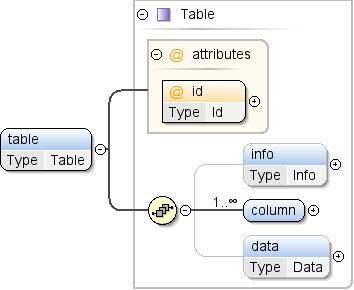 |
| ประเภท |
ตาราง |
| พร็อพเพอร์ตี้ |
| เนื้อหา: |
ซับซ้อน |
| maxOccurs: |
ไร้ขอบเขต |
|
| รุ่น |
info{0,1} , column+ , data{0,1} |
| เด็ก |
คอลัมน์, ข้อมูล, ข้อมูล |
| อินสแตนซ์ |
<table id="">
<info>{0,1}</info>
<column format="" id="" type="">{1,unbounded}</column>
<data>{0,1}</data>
</table>
|
| Attributes |
| QName |
ประเภท |
คงที่ |
ค่าเริ่มต้น |
ใช้ |
หมายเหตุ |
| id |
รหัส |
|
|
จำเป็น |
ตัวระบุที่ไม่ซ้ำกันของตารางใน
ชุดข้อมูล |
|
| แหล่งที่มา |
<xs:element name="table" type="Table" maxOccurs="unbounded"/>
|
แอตทริบิวต์: dspl / import / @namespace
| เนมสเปซ |
ไม่มีเนมสเปซ |
| คำอธิบายประกอบ |
เนมสเปซของชุดข้อมูลที่นำเข้า ซึ่งระบุเป็น URI ต
ต้องเชื่อมโยงคำนำหน้ากับเนมสเปซนี้ก่อนจึงจะแสดงเนื้อหาได้
มีการอ้างอิงถึง โปรดดู [เนมสเปซ XML] สำหรับข้อมูลเพิ่มเติมเกี่ยวกับการใช้
Namespace และคำนำหน้าใน XML |
| พร็อพเพอร์ตี้ |
|
| ใช้โดย |
|
| แหล่งที่มา |
<xs:attribute name="namespace" use="required">
<xs:annotation>
<xs:documentation>The namespace of the imported dataset, specified as
a URI. A prefix must be associated with this
namespace before its contents can be referenced. See
[XML Namespaces] for more information about the use
of namespaces and prefixes in XML.</xs:documentation>
</xs:annotation>
</xs:attribute>
|
แอตทริบิวต์: dspl / import / @location
| เนมสเปซ |
ไม่มีเนมสเปซ |
| คำอธิบายประกอบ |
ตำแหน่งที่ไม่บังคับซึ่งคำจำกัดความของที่นำเข้า
ระบุเป็น URL ได้ หากไม่ระบุตำแหน่ง แอตทริบิวต์
การประมวลผลชุดข้อมูล DSPL นี้ต้องทราบชุดข้อมูลที่นำเข้าอยู่แล้ว
ชุดข้อมูล หมายเหตุการใช้งาน: ผู้นำเข้าชุดข้อมูลของ Google จะไม่สนใจพารามิเตอร์
สถานที่ ชุดข้อมูลที่นำเข้าต้องเป็นที่รู้จักโดย Google
ผู้นำเข้าล่วงหน้า |
| พร็อพเพอร์ตี้ |
|
| ใช้โดย |
|
| แหล่งที่มา |
<xs:attribute name="location" use="optional">
<xs:annotation>
<xs:documentation>An optional location where the definition of the
imported dataset can be found, specified as a
URL. If the location is omitted, the system
processing this DSPL dataset must already know the
imported dataset.
Implementation note: The Google dataset importer
ignores the location attribute. Any imported dataset
must be known by the Google importer beforehand.</xs:documentation>
</xs:annotation>
</xs:attribute>
|
แอตทริบิวต์: dspl / @targetNamespace
| เนมสเปซ |
ไม่มีเนมสเปซ |
| คำอธิบายประกอบ |
ชุดข้อมูลแต่ละชุดอาจมีเนมสเปซเป้าหมาย เป้าหมาย
Namespace คือ URI ที่ระบุชุดข้อมูลโดยไม่ซ้ำกัน สำหรับข้อมูลเพิ่มเติม
ข้อมูลเกี่ยวกับการใช้เนมสเปซใน XML โปรดดู
http://www.w3.org/TR/REC-xml-names/ หากไม่ได้ระบุ targetNamespace
ระบบจะสร้างเนมสเปซเมื่อชุดข้อมูลคือ
นำเข้ามาเท่านั้น |
| ประเภท |
xs:anyURI |
| พร็อพเพอร์ตี้ |
|
| ใช้โดย |
|
| แหล่งที่มา |
<xs:attribute name="targetNamespace" type="xs:anyURI" use="optional">
<xs:annotation>
<xs:documentation>Each dataset may provide a target namespace. The
target namespace is a URI that uniquely identifies the
dataset. For more information about the use of namespaces in XML,
see:
http://www.w3.org/TR/REC-xml-names/
If no targetNamespace is provided, then a namespace will be
generated when the dataset is imported.</xs:documentation>
</xs:annotation>
</xs:attribute>
|
สร้างโดยใช้
ตัวแก้ไข XML ของ oXygen
เนื้อหาของหน้าเว็บนี้ได้รับอนุญาตภายใต้ใบอนุญาตที่ต้องระบุที่มาของครีเอทีฟคอมมอนส์ 4.0 และตัวอย่างโค้ดได้รับอนุญาตภายใต้ใบอนุญาต Apache 2.0 เว้นแต่จะระบุไว้เป็นอย่างอื่น โปรดดูรายละเอียดที่นโยบายเว็บไซต์ Google Developers Java เป็นเครื่องหมายการค้าจดทะเบียนของ Oracle และ/หรือบริษัทในเครือ
อัปเดตล่าสุด 2025-07-25 UTC
[null,null,["อัปเดตล่าสุด 2025-07-25 UTC"],[],["The DSPL XML schema defines a dataset's structure using key components: `tables`, `concepts`, `slices`, and `topics`. The root `dspl` element encapsulates the dataset, utilizing `import` to reference externals, `info` and `provider` for metadata, `attribute` for dataset attributes, and `topics` to hierarchically organize the concepts. `concepts`, `slices`, `tables` are for concept definition, slice definition, and data table, respectively. Each element like `import`, `info`, `provider`, `attribute`, `topic`, `concept`, `slice`, `table` uses specific attributes and child elements for configuration. Each element has a specific cardinality that is defined in the document.\n"]]












